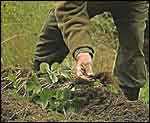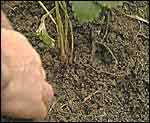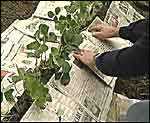Growing StrawberriesYou can't beat the taste of home-grown strawberries, and right now the garden centres are stocked up with young plants ready to go in the ground. Strawberries are one of the quickest of the berry fruits to produce a crop and not difficult to grow. You can grow them for several years, but for bigger and better produce it's best to treat them as annuals, as once they get older, problems with pests and diseases appear. The plants get old and tired and start to get competition between the crowns. They usually do not give the same performance in the second and subsequent years.
As for all plants, soil preparation is important. Enrich the strawberry bed with compost and bury some fowl manure between the rows in a shallow trench. This will provide a boost of food as the roots spread out. In heavy soils, plant on ridges to improve drainage, as strawberries are prone to root disease in very damp conditions. Plant at 15cm intervals. A warm sheltered site will help produce early berries and protect against frost at flowering time.
It's important with strawberries not to bury the crown. Keep the crown, which is the part just below the leaves, just above ground level, as shown here to the left. Many people plant on black plastic, as it keeps the plant clean. However, there can be some problems with black polythene in that the soil underneath deteriorates quickly because it's not a living membrane. An alternative is to use newspaper. Mulch can be placed on top of the newspaper.
Come spring, when the plants are starting to bear their fruit, put some straw down around the plants. This helps as a weed suppressant and mulch. The fruit will sit on top of the straw and stay clean and less likely to rot from contact with the soil. Also in spring apply more fertiliser (one containing potash) as this encourages sturdier plants, better fruit colour and quality and more disease resistance. To keep the birds off the fruit, cover the plants with netting just before fruiting begins. In late summer the strawberry plants will send off runners and these can be turned into new strawberry plants. Make sure your 'mother' plants are healthy: virus and pest free. The most vigorous runner tends to be the first one off the main clump, but you can try planting several runners.
Neaten the runners by cutting off any dead or damaged leaves and plant them in a seed tray containing an inert mix such as pumice, river sand or gravel. No fertiliser is required at this point. When you put in the cutting, once again don't bury the crown otherwise it will rot. New roots are formed as the plant sends out roots to search for nutrients. Water well and keep the seed tray in a damp, shady spot. After about 5-6 weeks you should find good roots on the cuttings and the plants can then be set out in the garden. STRAWBERRY POUCHES AND TERRACOTTA STRAWBERRY TOWERS You don't need a lot of room to grow strawberries. Provided you can give them a sunny spot, you can grow them in a terracotta strawberry tower or hang a strawberry pouch where the pesky birds can't get at the luscious fruit! Strawberry Pouch If using a strawberry pouch:
Terracotta Tower If using a terracotta or earthenware tower:
Also see:
|
Home | Journal
| Newsletter | Conferences
Awards | Join
RNZIH | RNZIH Directory | Links
© 2000–2025 Royal New Zealand Institute of Horticulture
Last updated: June 2, 2004







 From 5.30 with Jude and Maggies Garden Show
From 5.30 with Jude and Maggies Garden Show